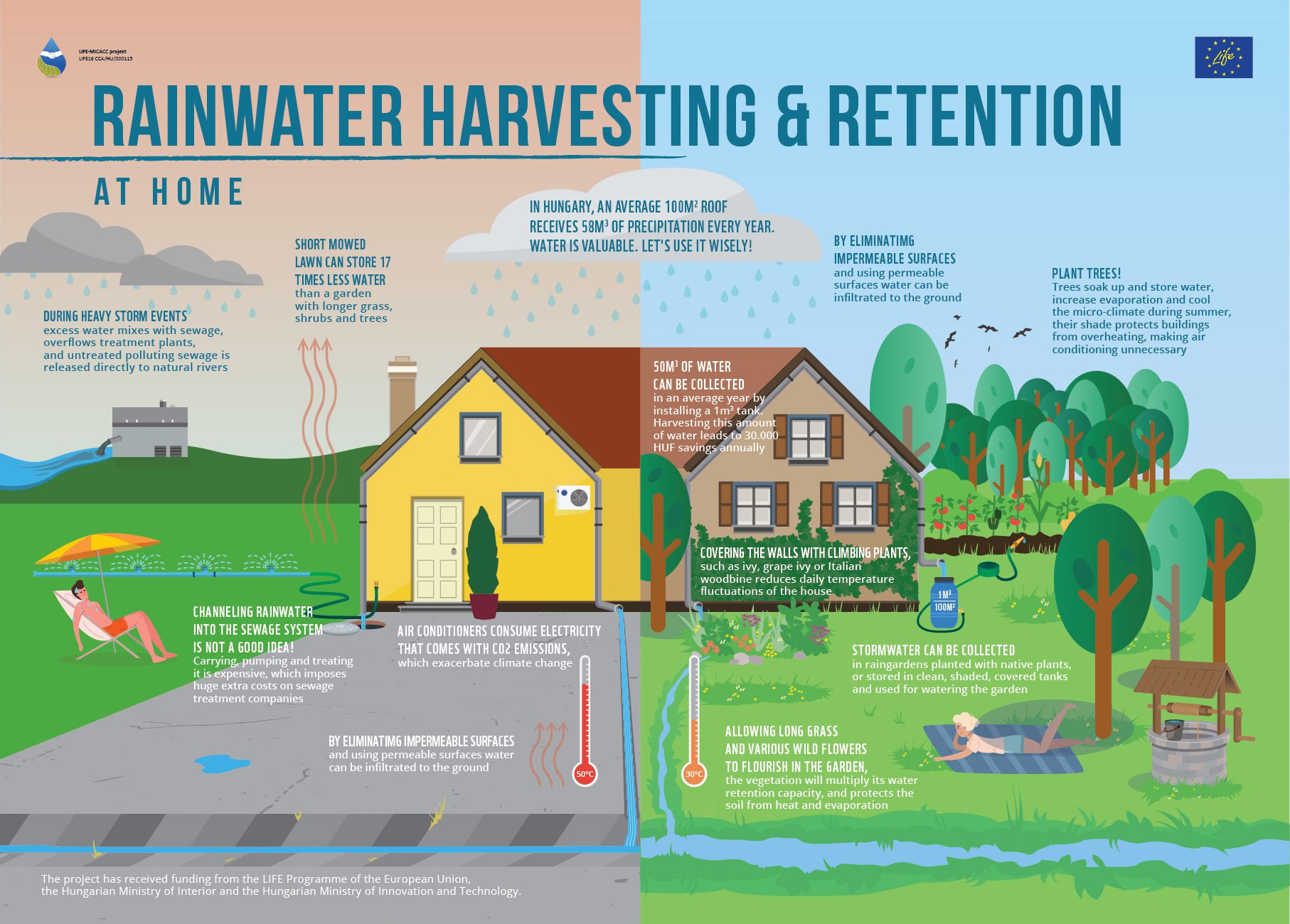LIFE-MICACC project
LIFE16 CCA/HU/000115
"Municipalities as integrators and coordinators
in adaptation to climate change"
LIFE-MICACC project
LIFE16 CCA/HU/000115
"Municipalities as integrators and coordinators
in adaptation to climate change"
By not draining the falling rain, but keeping it in our home, we not only do good for our wallets, but we can also effectively protect against heat and drought. In addition, we can do a lot to preserve the natural treasure which is the basis of all life. WWF Hungary gives tips on how to keep water around our house.
We can often feel helpless in the face of environmental problems: we think of them as too large-scale that we can’t act on as ordinary people. This is not true in most cases: everyone can do something to solve the big, system-level problems. It is the same with water management: in our own homes, doing ourselves a favour, we can protect our water resources by standing in the service of the common good.
Widespread, but bad: to get rid of the water to the last drop
In most households in Hungary, collecting water from roofs and paved surfaces is considered unnecessary and get drained, although it could be utilized. In the best scenario, the water is lead into public areas and drainage ditches – the water flowing out of the area is not used locally, but ends up in the Black Sea as it passes through an intertwined system of ditches, canals and rivers. The other problem is that this practice also makes flash floods and inland floods, which are becoming increasingly dense with climate change, unmanageable: it is not possible to build a drainage system that will completely drain the water of a fierce thunderstorm if water flows from all the roofs into the ditches immediately.
Worse than this, it is also a common solution when rainwater collected from the roof is led to a sewer. This is not only illegal, but also involves significant nature protection and material damages. The water entering the sewer has to be transported, pumped and treated in the wastewater management plants, which imposes a huge additional cost on the utilities’ operators. In addition, in case of heavy rain, wastewater management plants cannot receive wastewater mixed with plenty of rainwater and are forced to discharge it untreated into natural reservoirs – rivers, backwaters, lakes - , which often happens in Szentendre or Dél-Pest, on the Soroksár-Danube.
If everyone were to handle and utilize the rainwater inside their plot, it would make the gardens greener, more liveable and full of life at the same time and relieve local government of the costly task of solving drainage. It is time to realize that water is a resource and our homes need to be saved and managed accordingly. There are many options how to do this. The infographics of WWF Hungary, which was created as part of the LIFE-MICACC project, presents these. Within the framework of the project, the experts are working to enable smaller municipalities to adapt to the effects of climate change by retaining water.

This is how we can collect rainwater
An average of 58 m3 of water falls on a 100 m2 roof per year, of which about 50 m3 can be collected in a 1 m3 tank. If we use this much water for watering, for example, we could save an average of 32 000 HUF/year in water and sewer fees. Water can be collected in two ways: although the above-ground tanks are in mind, gravity can easily be used to carry water from them, for example for watering purposes. It is important that the tank used for collecting water to be clean, protected and covered from sunlight.
Tanks sunk into the ground and are more expensive but do not take up space in the garden. A cheaper solution is to collect rainwater in old cisterns after disinfection, from where the water can be utilized by pumping, but we can also infiltrate it into the ground to replenish the groundwater.
Improving the microclimate with plants
In addition to rainwater harvesting we can use water in other ways. Precipitation that overflows from tanks or drains from the roof can also be stored in a rain garden. Rain gardens are small depressions planted with water-loving native plant species that can be ornaments for the garden.
Vegetation also helps water retention in the rest of the garden: trees, shrubs or long-type grasses increase the garden’s natural water storage capacity. The lush vegetation is able to absorb a lot of water and gradually releases it into the atmosphere through evaporation. This is especially useful in summer, when evaporation helps cool the microclimate, making the heat more bearable. The long lawn and three-tiered vegetation are estimated to be able to store seventeen times more water than the short-cut English lawn.
Plants run on the house – such as five-leaved ivy, grape ivy or honeysuckle – also reduce the daily temperature fluctuations of the house. They work like a natural air conditioner; they contribute to capture and storage CO2, instead of just energy use and CO2 emissions.
It is important to reduce the proportion of paved surfaces where we can! The disadvantages of a paved terrace or driveway are that they overheat during the summer heat waves and the rain also flows away from them too quickly. Eliminating them or replacing them with water-permeable cover slows down the drain and increases the proportion of precipitation retained.

The infographics can be downloaded in large from the Documents.